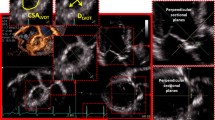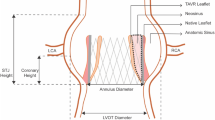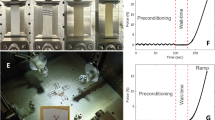Abstract
Computational models of aortic dissection can examine mechanisms by which this potentially lethal condition develops and propagates. We present results from phase-field finite element simulations that are motivated by a classical but seldom repeated experiment. Initial simulations agreed qualitatively and quantitatively with data, yet because of the complexity of the problem it was difficult to discern trends. Simplified analytical models were used to gain further insight. Together, simplified and phase-field models reveal power-law-based relationships between the pressure that initiates an intramural tear and key geometric and mechanical factors—insult surface area, wall stiffness, and tearing energy. The degree of axial stretch and luminal pressure similarly influence the pressure of tearing, which was ~88 kPa for healthy and diseased human aortas having sub-millimeter-sized initial insults, but lower for larger tear sizes. Finally, simulations show that the direction a tear propagates is influenced by focal regions of weakening or strengthening, which can drive the tear towards the lumen (dissection) or adventitia (rupture). Additional data on human aortas having different predisposing disease conditions will be needed to extend these results further, but the present findings show that physiologic pressures can propagate initial medial defects into delaminations that can serve as precursors to dissection.






Similar content being viewed by others
References
Ahmadzadeh, H., M. K. Rausch, and J. D. Humphrey. Modeling lamellar disruption within the aortic wall using a particle-based approach. Sci. Rep. 9:15320, 2019.
Alnæs, M., J. Blechta, J. Hake, A. Johansson, B. Kehlet, A. Logg, C. Richardson, J. Ring, M. E. Rognes, and G. N. Wells. The FEniCS project version 1.5. Arch. Numer. Softw. 3:9–23, 2015.
Aslanidou, L., M. Ferraro, G. Lovric, M. R. Bersi, J. D. Humphrey, P. Segers, B. Trachet, and N. Stergiopulos. Co-localization of microstructural damage and excessive mechanical strain at aortic branches in angiotensin-II-infused mice. Biomech. Model Mechanobiol. 19:81–97, 2020.
Ban, E., C. Cavinato, and J. D. Humphrey. Differential propensity of dissection along the aorta. Biomech. Model Mechanobiol. 20:895–907, 2021.
Bäumler, K., V. Vedula, A. M. Sailer, J. Seo, P. Chiu, G. Mistelbauer, F. P. Chan, M. P. Fischbein, A. L. Marsden, and D. Fleischmann. Fluid–structure interaction simulations of patient-specific aortic dissection. Biomech. Model Mechanobiol. 19:1607–1628, 2020.
Bellini, C., M. R. Bersi, A. W. Caulk, J. Ferruzzi, D. M. Milewicz, F. Ramirez, D. B. Rifkin, G. Tellides, H. Yanagisawa, and J. D. Humphrey. Comparison of 10 murine models reveals a distinct biomechanical phenotype in thoracic aortic aneurysms. J. R. Soc. Interface. 14:20161036, 2017.
Bellini, C., N. J. Kristofik, M. R. Bersi, T. R. Kyriakides, and J. D. Humphrey. A hidden structural vulnerability in the thrombospondin-2 deficient aorta increases the propensity to intramural delamination. J. Mech. Behav. Biomed. Mater. 71:397–406, 2017.
Bersi, M. R., C. Bellini, J. D. Humphrey, and S. Avril. Local variations in material and structural properties characterize murine thoracic aortic aneurysm mechanics. Biomech. Model Mechanobiol. 18:203–218, 2019.
Bersi, M. R., R. Khosravi, A. J. Wujciak, D. G. Harrison, and J. D. Humphrey. Differential cell-matrix mechanoadaptations and inflammation drive regional propensities to aortic fibrosis, aneurysm or dissection in hypertension. J. R. Soc. Interface. 14:20170327, 2017.
Bourdin, B., G. A. Francfort, and J.-J. Marigo. The variational approach to fracture. J. Elast. 91:5–148, 2008.
Campbell, J. D. On the theory of initially tensioned circular membranes subjected to uniform pressure. Q. J. Mech. Appl. Math. 9:84–93, 1956.
Carson, M. W., and M. R. Roach. The strength of the aortic media and its role in the propagation of aortic dissection. J. Biomech. 23:579–588, 1990.
de Beaufort, H. W. L., A. Ferrara, M. Conti, F. L. Moll, J. A. van Herwaarden, C. A. Figueroa, J. Bismuth, F. Auricchio, and S. Trimarchi. Comparative analysis of porcine and human thoracic aortic stiffness. Eur. J. Vasc. Endovasc. Surg. 55:560–566, 2018.
Dillon-Murphy, D., A. Noorani, D. Nordsletten, and C. A. Figueroa. Multi-modality image-based computational analysis of haemodynamics in aortic dissection. Biomech. Model Mechanobiol. 15:857–876, 2016.
Dingemans, K. P., P. Teeling, A. C. van der Wal, and A. E. Becker. Ultrastructural pathology of aortic dissections in patients with Marfan syndrome: comparison with dissections in patients without Marfan syndrome. Cardiovasc. Pathol. 15:203–212, 2006.
Ferruzzi, J., D. Madziva, A. W. Caulk, G. Tellides, and J. D. Humphrey. Compromised mechanical homeostasis in arterial aging and associated cardiovascular consequences. Biomech. Model Mechanobiol. 17:1281–1295, 2018.
García-Herrera, C. M., D. J. Celentano, M. A. Cruchaga, F. J. Rojo, J. M. Atienza, G. V. Guinea, and J. M. Goicolea. Mechanical characterisation of the human thoracic descending aorta: experiments and modelling. Comput. Methods Biomech. Biomed. Eng. 15:185–193, 2012.
Gent, A. N., and L. H. Lewandowski. Blow-off pressures for adhering layers. J. Appl. Polym. Sci. 33:1567–1577, 1987.
Griffith, A. A. VI. The phenomena of rupture and flow in solids. Philos. Trans. R. Soc. Lond. Ser. A. 221:163–198, 1921.
Gültekin, O., S. P. Hager, H. Dal, and G. A. Holzapfel. Computational modeling of progressive damage and rupture in fibrous biological tissues: application to aortic dissection. Biomech. Model Mechanobiol. 18:1607–1628, 2019.
Guo, D.-C., E. S. Regalado, C. Minn, V. Tran-Fadulu, J. Coney, J. Cao, M. Wang, R. K. Yu, A. L. Estrera, H. J. Safi, S. S. Shete, and D. M. Milewicz (2011) Familial Thoracic Aortic Aneurysms and Dissections. Circulation 4:36–42
Hughes, T. J. R. The Finite Element Method: Linear Static and Dynamic Finite Element Analysis. North Chelmsford: Courier Corporation, p. 706, 2012.
Humphrey, J. D. Possible mechanical roles of glycosaminoglycans in thoracic aortic dissection and associations with dysregulated TGF-β. J. Vasc. Res. 50:1–10, 2013.
Kawamura, Y., S.-I. Murtada, F. Gao, X. Liu, G. Tellides, and J. D. Humphrey. Adventitial remodeling protects against aortic rupture following late smooth muscle-specific disruption of TGFβ signaling. J. Mech. Behav. Biomed. Mater. 116:104264, 2021.
Keramati, H., E. Birgersson, J. P. Ho, S. Kim, K. J. Chua, and H. L. Leo. The effect of the entry and re-entry size in the aortic dissection: a two-way fluid–structure interaction simulation. Biomech. Model Mechanobiol. 19:2643–2656, 2020.
Pal, S., A. Tsamis, S. Pasta, A. D’Amore, T. G. Gleason, D. A. Vorp, and S. Maiti. A mechanistic model on the role of “radially-running” collagen fibers on dissection properties of human ascending thoracic aorta. J. Biomech. 47:981–988, 2014.
Pape, L. A., T. T. Tsai, E. M. Isselbacher, J. K. Oh, P. T. Ogara, A. Evangelista, R. Fattori, G. Meinhardt, S. Trimarchi, E. Bossone, T. Suzuki, J. V. Cooper, J. B. Froehlich, C. A. Nienaber, and K. A. Eagle. Aortic diameter ≥5.5 cm is not a good predictor of type A aortic dissection. Circulation. 116:1120–1127, 2007.
Pasta, S., J. A. Phillippi, T. G. Gleason, and D. A. Vorp. Effect of aneurysm on the mechanical dissection properties of the human ascending thoracic aorta. J. Thorac. Cardiovasc. Surg. 143:460–467, 2012.
Rivlin, R. S., and A. G. Thomas. Rupture of rubber. I. Characteristic energy for tearing. J. Polym. Sci. 10:291–318, 1953.
Roach, M. R., J. C. He, and R. G. Kratky. Tear propagation in isolated, pressurized porcine thoracic aortas. Can. J. Cardiol. 15:569–575, 1999.
Roach, M. R., and S. H. Song. Variations in strength of the porcine aorta as a function of location. Clin. Invest. Med. 17:308–318, 1994.
Roccabianca, S., G. A. Ateshian, and J. D. Humphrey. Biomechanical roles of medial pooling of glycosaminoglycans in thoracic aortic dissection. Biomech. Model Mechanobiol. 13:13–25, 2014.
Roccabianca, S., C. A. Figueroa, G. Tellides, and J. D. Humphrey. Quantification of regional differences in aortic stiffness in the aging human. J. Mech. Behav. Biomed. Mater. 29:618–634, 2014.
Sherifova, S., and G. A. Holzapfel. Biomechanics of aortic wall failure with a focus on dissection and aneurysm: a review. Acta Biomater. 99:1–17, 2019.
Sommer, G., S. Sherifova, P. J. Oberwalder, O. E. Dapunt, P. A. Ursomanno, A. DeAnda, B. E. Griffith, and G. A. Holzapfel. Mechanical strength of aneurysmatic and dissected human thoracic aortas at different shear loading modes. J. Biomech. 49:2374–2382, 2016.
Thunes, J. R., J. A. Phillippi, T. G. Gleason, D. A. Vorp, and S. Maiti. Structural modeling reveals microstructure-strength relationship for human ascending thoracic aorta. J. Biomech. 71:84–93, 2018.
Tong, J., Y. Cheng, and G. A. Holzapfel. Mechanical assessment of arterial dissection in health and disease: advancements and challenges. J. Biomech. 49:2366–2373, 2016.
Wang, L., S. M. Roper, N. A. Hill, and X. Luo. Propagation of dissection in a residually-stressed artery model. Biomech. Model Mechanobiol. 16:139–149, 2017.
Wang, R., X. Yu, and Y. Zhang. Mechanical and structural contributions of elastin and collagen fibers to interlamellar bonding in the arterial wall. Biomech. Model Mechanobiol. 20:93–106, 2021.
Weinsaft, J. W., et al. Aortic dissection in patients with genetically mediated aneurysms: incidence and predictors in the GenTAC registry. J. Am. Coll. Cardiol. 67:2744–2754, 2016.
Williams, M. L. The continuum interpretation for fracture and adhesion. J. Appl. Polym. Sci. 13:29–40, 1969.
Yu, X., B. Suki, and Y. Zhang. Avalanches and power law behavior in aortic dissection propagation. Sci. Adv. 6:eaaz1173, 2020.
Acknowledgments
We thank the Sinusas Lab at Yale University for providing us with aortic tissue samples. This work was supported, in part, by a grant from the US National Institutes of Health (U01 HL142518).
Author information
Authors and Affiliations
Corresponding author
Ethics declarations
Conflict of interest
The authors declare that they have no conflict of interest.
Additional information
Associate Editor Ender A. Finol oversaw the review of this article.
Publisher's Note
Springer Nature remains neutral with regard to jurisdictional claims in published maps and institutional affiliations.
The original article was revised to correct the editorial responsibility line.
Electronic supplementary material
Below is the link to the electronic supplementary material.
Appendix: Pressure of Tearing in Analytical Models of Two Adhered Linearly Elastic Plates or Membranes
Appendix: Pressure of Tearing in Analytical Models of Two Adhered Linearly Elastic Plates or Membranes
In our previous study of region-specificity of dissections,4 we used mathematical relationships amongst critical pressure, stiffness, and characteristic energy of tearing proposed by Gent and Lewandowski18 to model delamination by injection of cut-open arterial segments. To obtain similar mathematical relations in the case of an inflated artery we built simplified models that extend the analysis of Gent and Lewandowski to include two flaps of tissue interleaved by two pools of pressurized fluid (Figs. 3, 7). The pressure of the false lumen deforms the two flaps of tissue while the pressure of the true lumen resists the deformation of the inner flap, with the mechanics of the four elements coupled.
Schematic of the deformation of the inner and outer flaps of the aortic wall by the pressure of the true lumen and the intramural pressure of injection in the false lumen. The pressure of the false lumen deforms the outer flap of tissue while the differential of pressure of the true and false lumens deforms the inner flap. The interaction of the two pools of fluid is modeled by the loss of the volume of false lumen as the volume of the true lumen increases and vice versa.
Consistent with the computational models, we employed an energy-based approach19 to find the critical pressure required to separate two adhered linear elastic circular plates or membranes in the presence of a counter-acting fluid pressure acting over the outer surface of one of the circular elements (Figs. 3b and 3c). In these minimalistic models, we neglect the deformation of the artery outside of the circular areas. The solid bodies share the same radius \(a\), thickness, \(h\), elastic modulus, \(E\), and Poisson’s ratio, \(\nu\). The energy required to advance the torn surface per unit area is \(G_{c}\). The energy-based approach requires evaluation of the total energy that consists of the energies of the elastic deformation of the inner and outer flaps of tissue, \(U_{{{\text{inner}}}}\) and \(U_{{{\text{outer}}}}\), the energy loss by the pressure in the true and false lumens, \(- P_{{{\text{tl}}}} {\Delta }V_{{{\text{tl}}}}\) and \(- P_{{{\text{fl}}}} {\Delta }V_{{{\text{fl}}}}\), and finally the energy of tearing \(\pi a^{2} G_{c}\). The volumes of the true and false lumens and the deformation of the flaps interact such that \({\Delta }V_{{{\text{fl}}}} = V_{{{\text{out}} - {\text{flap}}}} + V_{{{\text{in}} - {\text{flap}}}}\), with \({\Delta }V_{{{\text{tl}}}} = - V_{{{\text{in}} - {\text{flap}}}}\). \(V_{{{\text{out}} - {\text{flap}}}}\) and \(V_{{{\text{in}} - {\text{flap}}}}\) are the volumes of fluid enclosed by the deformed outer and inner flaps. In comparison with the energy in the finite element implementation, instead of prescribing the injection volume, here we consider the state of deformation and tearing due to application of a constant pressure at the false lumen. The stationary point of the total energy with respect to the tear size determines the pressure of tearing.
In the case of the small deformation of a single linearly elastic plate, the axisymmetric displacement of a thin plate,\(w\left( {\hat{r}} \right)\), at a radius \(\hat{r}\) is governed by \(\nabla^{2} \nabla^{2} w\left( {\hat{r}} \right) = P/B\). \(P\) is the total uniformly distributed pressure and \(B = {Eh}^{3} /\left( {12\left( {1 - v^{2} } \right)} \right)\) is the bending stiffness of the plate. Given the prescribed zero displacement at the periphery of the plate (Fig. 3c) and the non-zero displacement in the middle of the plate, \(w\left( {\hat{r}} \right) = P\left( {\hat{r}^{2} - a^{2} } \right)^{2} /\left( {64B} \right)\). If we consider that the torn area is initially negligible, the energy required to produce a torn area of radius \(a\) is \(E_{{{\text{tear}}}} = \pi a^{2} G_{c}\).41 The volume of fluid enclosed by the deforming plate is \(V = \int_A w({\hat{r}}){{d}}A \), where \(A\) is the circular area of the plate before deformation. The elastically stored energy in the plate is \(U = a^{6} P^{2} \pi \left( {1 - v^{2} } \right)/\left( {32{{Eh}}^{3} } \right)\).
The outside plate, located between the false lumen and the outside surface of the vessel, is loaded by the pressure from the false lumen, \(P = P_{{{\text{tear}} - {\text{fl}}}}\), whereas, the inside plate, sandwiched between the true and false lumens, is loaded by the differential of pressure of the two \(P = P_{{{\text{tear}} - {\text{fl}}}} - P_{{{\text{true}} - {\text{lumen}}}}\). Following the approach of Griffith,19 the critical pressure of tearing corresponds to the tear size at the stationary point of \(E_{{{\text{total}}}}\), that is, where \(\partial E_{{{\text{total}}}} /\partial a = 0\). In the case of two-plates,
For the tear to advance between two deforming membranes (without bending stiffness) interleaved by two pools of fluid, we extend the analysis of Gent and Lewandowski18 for a single membrane. The change of potential of the fluid pressure is \(- {{PV}}\). The deformation of the membrane may be characterized by approximate relations for the maximum deflection of the membrane, \(\delta\), and the volume of the fluid enclosed by the membrane: \(\delta = C_{2} ({{Pa}}^{4} /\left( {{Eh}} \right))^{1/3}\) and \(V = C_{1} \pi a^{2} \delta\). Since \(P \propto V^{3}\), and \(U = \int_{V} P \,dV \), \(U = {{PV}}/4\) in case of the nonlinear deformation of the membrane. By repeating the same steps as in the case of two plates, we obtain the relationship
Importantly, both Eqs. (6 and 7) suggest power-law relations for tear resistance, which motivated a new interpretation of nonlinear finite element results as shown in Figs. 4 and 5. Models with tense membranes11 and beams are presented in more detail in the Supplementary Information (Eqs. S4–S14), which similarly support this interpretation.
Rights and permissions
About this article
Cite this article
Ban, E., Cavinato, C. & Humphrey, J.D. Critical Pressure of Intramural Delamination in Aortic Dissection. Ann Biomed Eng 50, 183–194 (2022). https://doi.org/10.1007/s10439-022-02906-3
Received:
Accepted:
Published:
Issue Date:
DOI: https://doi.org/10.1007/s10439-022-02906-3





